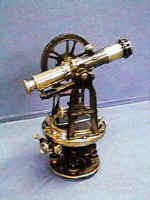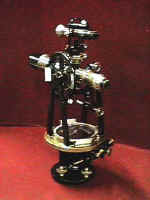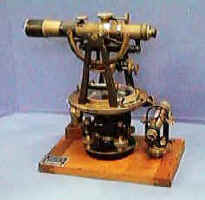|
Bausch
& Lomb Optical Company (now just Bausch & Lomb, Incorporated), was
founded in 1853 by John J. Bausch and Henry Lomb. German born, Bausch and
Lomb settled in Rochester, New York, where John Bausch started a small business
making eyeglasses. He was soon joined by Henry Lomb. The firm
remained small until they bought the rights to make eyeglass frames of
"Vulcanite", an early form of hard rubber. By the late 19th
century the firm was flourishing with John's son, Edward Bausch, taking a
very active role. Edward Bausch added the manufacture
of microscopes to the company's product line, and by 1900, the company was
making microscopes and accessories, slide and opaque projectors, photographic
lenses and prism binoculars--but no surveying or engineering instruments.
That
changed in 1905 when George N. Saegmuller moved his company from
Washington, D. C. to join with Bausch & Lomb in a new firm, the Bausch, Lomb,
Saegmuller Company. This new company was established to manufacture
geodetic and engineering instruments and, most importantly, rangefinders and
gun sighting devices for military use. This firm continued from the spring
of 1905 to the end of 1907.
For
some years previously, Bausch & Lomb had been making binoculars and
photographic lenses under license to Carl Zeiss, of Jena, Germany; the
world's leading optical manufacture at that time. In 1907, Zeiss bought
20% of Bausch & Lomb and about 33% of Bausch,
Lomb, Saegmuller.
The
company was renamed Bausch & Lomb but was known as the "Triple
Alliance" and the new logo featured three prisms, each with the initials of
the participating organizations: "B-L", "Z" and
"S". This partnership continued until November 1915 when the
conflicts of World War I ended the "Triple Alliance" because Bausch
& Lomb was selling military equipment to Great Britain, Germany's enemy.
Production
of surveying instruments ceased sometime between the entry of the United States
into World War I in April 1917 and the spring of 1918, when production of goods
for civilian use was suspended. Bausch
& Lomb concentrated its efforts on making rangefinders, gun sights,
binoculars, trench periscopes, search light mirrors, optical glass and other
materials for military use. At the end of World War I in 1918, Bausch
& Lomb decided not to return to making engineering instruments.
Competition from long established firms like W. & L. E. Gurley, Keuffel &
Esser,
Buff
& Buff, and C. L. Berger & Sons was too great. Bausch & Lomb
had developed a very successful military business which it continued to exploit.
~Thomas Garver
 |
|
ALL INSTRUMENTS
PICTURED IN THE BAUSCH & LOMB DISPLAY ARE OWNED BY
THE MUSEUM OF
SURVEYING
LANSING, MICHIGAN |
|
 |
|
Mining &
Reconnaissance Transit thought to have been used in the building of
the
Sault Locks |
|
|
|
Transit with Saegmuller Solar
attachment donated by the estate of
RALPH MOORE BERRY |
|
|
 |
